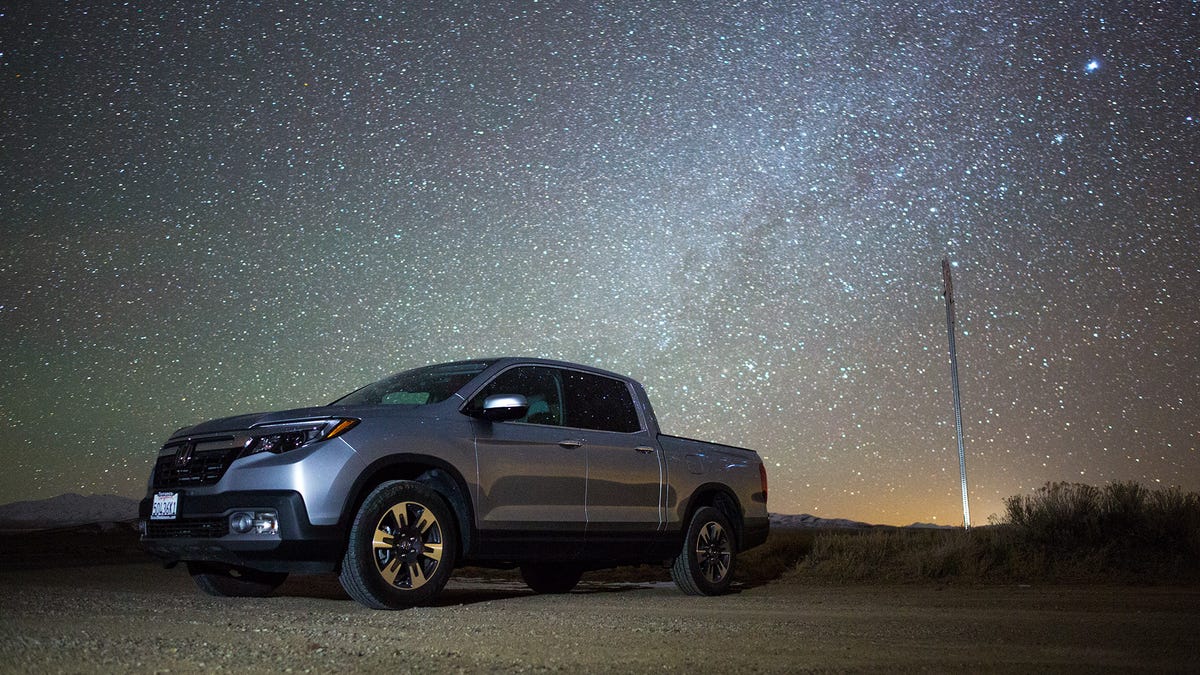2017 Honda Ridgeline long-term update: Seeing stars like we've never before
We drive our long-term test truck into the darkest, coldest night we've ever seen to capture some amazing interstellar footage.

It's been nearly four months and 5,000 miles since we've adopted our 2017 Honda Ridgeline test truck, and we're still loving it and using the approachable pickup for everything from moving bulky items to towing a race car to simple transportation. It has continued to impress us with its flexibility.
Our video producers have especially taken to the Ridgeline, using the truck as a production vehicle thanks to its ability to securely hold all of our sensitive camera equipment in its cabin, bed and in-bed trunk. Just outside of frame in every film our SF crew has produced in 2017 sits our Honda Ridgeline.
So, when video producer extraordinaire Marc Ganley expressed an interest in night-lapse photography, we dragged him and the Ridgeline in front of the cameras for a Roadshow road trip, giving you a behind-the-scenes look at the entire adventure.
A night lapse is a type of time-lapse photography that involves taking multiple, long exposures of the night sky to create stunning video of stellar bodies. We started our planning off-camera, using an online light pollution map to find an area we could drive to with the darkest skies and a calendar to find the next new moon phase for maximum star visibility. Once we had a date and an approximate location, we loaded up the Ridgeline and hit the road.
The drive to the nearest dark zone -- somewhere outside of Fallon, Nevada -- was a 5-hour cruise from our San Francisco office. Along the way, we experimented with the Honda's driver aid features and even got a bit turned around when we ventured off of the beaten path into the snowy mountains of the California-Nevada border. Thankfully, a combination of Android Auto's Google Maps and the Honda's onboard Garmin maps got where we were going.
After a meal and a few hours waiting for the sun to set, we loaded up and headed into the night. The Ridgeline's optional automatic high beams came in handy here, illuminating the dark roads with a long cast, but automatically dipping when the rare oncoming vehicle was detected. Our online scouting only led us so far, but after a couple of hours blindly exploring smaller and smaller side roads, we found a quiet spot where the camera could capture its long exposures undisturbed.
We were prepared for the night to be dark, but neither of us had ever been outside in such a black night. We'd also underestimated the chill as the desert temperature rapidly dropped below the freezing point. We could hear coyotes howling in the distance, but couldn't see an inch past our noses without a flashlight.
But then our eyes adjusted and we were treated to the most amazing night sky I've ever seen. We'd lucked out and picked a night that was both dark, but also clear. It was like looking straight into space the stars were so brilliant and numerous. The view alone was worth the day's drive and I could have just stood there staring up, but we quickly set about setting up the gear.
Marc tells me that each shot is composed of about 180-200 30-second long exposures of the night sky captured in sequence. Later, he stitched those shots together with software to create a film that, when played back at 25 fps, compressed the three hours of photography the camera captured while we huddled shivering in the dark to just over 15 seconds of video. It's short, but truly spectacular, and Marc and I both agree that it was worth the trip.

